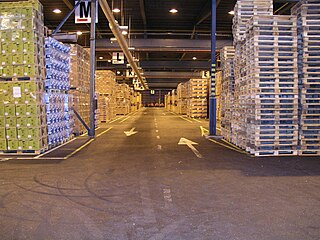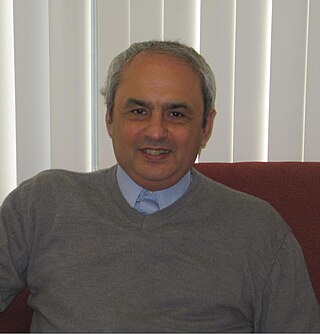Related Research Articles

Queueing theory is the mathematical study of waiting lines, or queues. A queueing model is constructed so that queue lengths and waiting time can be predicted. Queueing theory is generally considered a branch of operations research because the results are often used when making business decisions about the resources needed to provide a service.
Lajos Takács was a Hungarian mathematician, known for his contributions to probability theory and in particular, queueing theory. He wrote over two hundred scientific papers and six books.
In queueing theory, a discipline within the mathematical theory of probability, a BCMP network is a class of queueing network for which a product-form equilibrium distribution exists. It is named after the authors of the paper where the network was first described: Baskett, Chandy, Muntz, and Palacios. The theorem is a significant extension to a Jackson network allowing virtually arbitrary customer routing and service time distributions, subject to particular service disciplines.
In queueing theory, a discipline within the mathematical theory of probability, Burke's theorem is a theorem asserting that, for the M/M/1 queue, M/M/c queue or M/M/∞ queue in the steady state with arrivals is a Poisson process with rate parameter λ:
- The departure process is a Poisson process with rate parameter λ.
- At time t the number of customers in the queue is independent of the departure process prior to time t.
In probability theory, a product-form solution is a particularly efficient form of solution for determining some metric of a system with distinct sub-components, where the metric for the collection of components can be written as a product of the metric across the different components. Using capital Pi notation a product-form solution has algebraic form
In queueing theory, a discipline within the mathematical theory of probability, quasireversibility is a property of some queues. The concept was first identified by Richard R. Muntz and further developed by Frank Kelly. Quasireversibility differs from reversibility in that a stronger condition is imposed on arrival rates and a weaker condition is applied on probability fluxes. For example, an M/M/1 queue with state-dependent arrival rates and state-dependent service times is reversible, but not quasireversible.

In applied probability, a regenerative process is a class of stochastic process with the property that certain portions of the process can be treated as being statistically independent of each other. This property can be used in the derivation of theoretical properties of such processes.
Ward Whitt is an American professor of operations research and management sciences. He is a professor emeritus of the Industrial Engineering and Operations Research department of Columbia University. His research focuses on queueing theory, performance analysis, stochastic models of telecommunication systems, and numerical transform inversion. He is recognized for his contributions to the understanding and analyses of complex queues and queuing networks, which led to advances in the telecommunications system.
In queueing theory, a discipline within the mathematical theory of probability, a fluid queue is a mathematical model used to describe the fluid level in a reservoir subject to randomly determined periods of filling and emptying. The term dam theory was used in earlier literature for these models. The model has been used to approximate discrete models, model the spread of wildfires, in ruin theory and to model high speed data networks. The model applies the leaky bucket algorithm to a stochastic source.
In queueing theory, a discipline within the mathematical theory of probability, an M/G/k queue is a queue model where arrivals are Markovian, service times have a General distribution and there are k servers. The model name is written in Kendall's notation, and is an extension of the M/M/c queue, where service times must be exponentially distributed and of the M/G/1 queue with a single server. Most performance metrics for this queueing system are not known and remain an open problem.
In probability theory, a piecewise-deterministic Markov process (PDMP) is a process whose behaviour is governed by random jumps at points in time, but whose evolution is deterministically governed by an ordinary differential equation between those times. The class of models is "wide enough to include as special cases virtually all the non-diffusion models of applied probability." The process is defined by three quantities: the flow, the jump rate, and the transition measure.
In probability theory, reflected Brownian motion is a Wiener process in a space with reflecting boundaries. In the physical literature, this process describes diffusion in a confined space and it is often called confined Brownian motion. For example it can describe the motion of hard spheres in water confined between two walls.
In queueing theory, a discipline within the mathematical theory of probability, a bulk queue is a general queueing model where jobs arrive in and/or are served in groups of random size. Batch arrivals have been used to describe large deliveries and batch services to model a hospital out-patient department holding a clinic once a week, a transport link with fixed capacity and an elevator.
In queueing theory, a discipline within the mathematical theory of probability, a heavy traffic approximation is the matching of a queueing model with a diffusion process under some limiting conditions on the model's parameters. The first such result was published by John Kingman who showed that when the utilisation parameter of an M/M/1 queue is near 1 a scaled version of the queue length process can be accurately approximated by a reflected Brownian motion.
In queueing theory, a discipline within the mathematical theory of probability, a D/M/1 queue represents the queue length in a system having a single server, where arrivals occur at fixed regular intervals and job service requirements are random with an exponential distribution. The model name is written in Kendall's notation. Agner Krarup Erlang first published a solution to the stationary distribution of a D/M/1 and D/M/k queue, the model with k servers, in 1917 and 1920.

In queueing theory, a discipline within the mathematical theory of probability, a polling system or polling model is a system where a single server visits a set of queues in some order. The model has applications in computer networks and telecommunications, manufacturing and road traffic management. The term polling system was coined at least as early as 1968 and the earliest study of such a system in 1957 where a single repairman servicing machines in the British cotton industry was modelled.
In queueing theory, a discipline within the mathematical theory of probability, a fluid limit, fluid approximation or fluid analysis of a stochastic model is a deterministic real-valued process which approximates the evolution of a given stochastic process, usually subject to some scaling or limiting criteria.
Ruth Jeannette Williams is an Australian-born American mathematician at the University of California, San Diego where she holds the Charles Lee Powell Chair as a Distinguished Professor of Mathematics. Her research concerns probability theory and stochastic processes.
Stochastic scheduling concerns scheduling problems involving random attributes, such as random processing times, random due dates, random weights, and stochastic machine breakdowns. Major applications arise in manufacturing systems, computer systems, communication systems, logistics and transportation, and machine learning, among others.

Eugene A. Feinberg is an American mathematician and distinguished professor of applied mathematics and statistics at Stony Brook University. He is noted for his work in probability theory, real analysis, and Markov decision processes.
References
- 1 2 3 "Amber Puha, PhD | CSUSM". faculty.csusm.edu. Retrieved 2022-04-20.
- ↑ "Amber Puha - The Mathematics Genealogy Project". mathgenealogy.org. Retrieved 2022-04-21.
- ↑ "Faculty Directory | Department of Mathematics | CSUSM". www.csusm.edu. Retrieved 2022-04-21.
- ↑ Puha, Amber (2000). "Critical Exponents for a Reversible Nearest Particle System on the Binary Tree". The Annals of Probability. 28. doi: 10.1214/aop/1019160124 .
- ↑ Puha, Amber; Alexander, Stolyar; Ruth, Williams (2006). "The Fluid Limit of an Overloaded Processor Sharing Queue". Mathematics of Operations Research . 31 (2): 316–350. doi:10.1287/moor.1050.0181.
- ↑ Down, Douglas; Gromoll, H. Christian; Puha, Amber (2009). "Fluid Limits for Shortest Remaining Processing Time Queues". Mathematics of Operations Research . 34 (4): 880–911. doi:10.1287/moor.1090.0409.
- ↑ Down, Douglas; Gromoll, H. Christian; Puha, Amber (2009). "State-dependent response times via fluid limits in shortest remaining processing time queues". ACM SIGMETRICS Performance Evaluation Review. 37 (2): 75–76. doi:10.1145/1639562.1639593. S2CID 2880499.
- ↑ Gromoll, H. Christian; Kruk, Lukasz; Puha, Amber (2011). "Diffusion limits for shortest remaining processing time queues". Stochastic Systems. 1: 1–16. arXiv: 1005.1035 . doi: 10.1214/10-SSY016 .
- ↑ Jennings, Otis; Puha, Amber (2013). "Fluid Limits for Overloaded Multiclass FIFO Single-Server Queues with General Abandonment". Stochastic Systems. 3: 262–321. arXiv: 1210.0959 . doi: 10.1287/12-SSY085 .
- ↑ Puha, Amber (2015). "Diffusion limits for shortest remaining processing time queues under nonstandard spatial scaling". The Annals of Applied Probability. 25 (6). arXiv: 1407.3837 . doi: 10.1214/14-AAP1076 .
- ↑ Puha, Amber; Williams, Ruth (2016). "Asymptotic Behavior of a Critical Fluid Model for a Processor Sharing Queue via Relative Entropy". Stochastic Systems. 6 (2): 251–300. doi: 10.1287/15-SSY198 .
- ↑ Mulvany, Justin; Puha, Amber; Williams, Ruth (2019). "Asymptotic Behavior of a Critical Fluid Model for a Multiclass Processor Sharing Queue via Relative Entropy". Queueing Systems. 93 (3–4): 351–397. doi: 10.1007/s11134-019-09629-8 .
- ↑ Puha, Amber; Ward, Amy (2019). "Scheduling an Overloaded Multiclass Many-Server Queue with Impatient Customers". Tutorials in Operations Research: 189–217. doi:10.1287/educ.2019.0196. ISBN 978-0-9906153-3-0. S2CID 85505491.
- ↑ Puha, Amber; Ward, Amy (2021). "Fluid Limits for Multiclass Many Server Queues with General Reneging Distribution and General Head-of-the-Line Scheduling Policies". Mathematics of Operations Research . doi:10.1287/moor.2021.1166. S2CID 202120734.
- ↑ Zhong, Yueyang; Ward, Amy; Puha, Amber (2022). "Asymptotically Optimal Idling in the GI/GI/N+GI Queue". Operations Research Letters . 50 (3): 362–369. arXiv: 2106.11407 . doi: 10.1016/j.orl.2022.04.005 .
- ↑ Gromoll, H. Christian; Puha, Amber; Williams, Ruth (2002). "The fluid limit of a heavily loaded processor sharing queue". The Annals of Applied Probability. 12 (3). doi: 10.1214/aoap/1031863171 .
- ↑ Puha, Amber; Williams, Ruth (2004). "Invariant states and rates of convergence for a critical fluid model of a processor sharing queue". The Annals of Applied Probability. 14 (2). arXiv: math/0405289 . doi: 10.1214/105051604000000017 .
- ↑ Dai, J.G. “Jim”; Taylor, Peter; Mandelbaum, Avishai. "INFORMS 2007 Best Publication Award Citation" . Retrieved 6 May 2022.
- ↑ "Council Past Members". AMS. Retrieved 18 April 2022.
- ↑ "Previous Prize Selection Committee Members". INFORMS. Retrieved 18 April 2022.
- ↑ "Institute of Mathematical Statistics | Past Committee Members". imstat.org. Retrieved 2022-05-10.
- ↑ "SoCal Probability". scps.pstat.ucsb.edu. Retrieved 2022-04-20.
- ↑ "Editorial Board | Mathematics of Operations Research". pubsonline.informs.org. Retrieved 2022-05-10.
- ↑ "AMS Committees". American Mathematical Society. Retrieved 2023-03-27.
- ↑ Aragon, Janice. "2009 NSSA NATIONAL CHAMPIONSHIP WRAP UP AND RESULTS!". NSSA. Retrieved 18 April 2022.
- ↑ NSSA. "2019 NATIONAL CHAMPIONSHIP RESULTS!". NSSA. Retrieved 18 April 2022.
- ↑ "APS Best Publication Award: Past Winners". INFORMS. Retrieved 18 April 2022.
- ↑ "Previous Awardees: President's Outstanding Faculty Awards". CSUSM. Retrieved 18 April 2022.